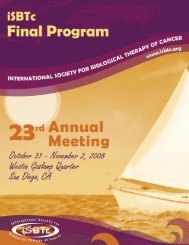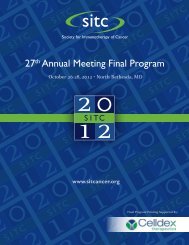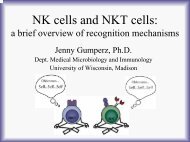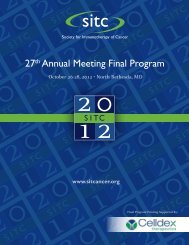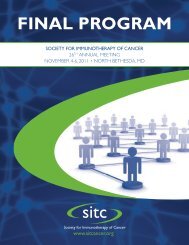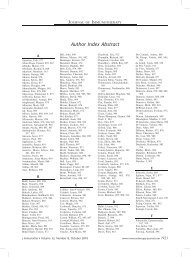Abstracts for the 25th Annual Scientific Meeting of the International ...
Abstracts for the 25th Annual Scientific Meeting of the International ...
Abstracts for the 25th Annual Scientific Meeting of the International ...
Create successful ePaper yourself
Turn your PDF publications into a flip-book with our unique Google optimized e-Paper software.
J Immuno<strong>the</strong>r Volume 33, Number 8, October 2010<br />
<strong>Abstracts</strong><br />
Results: 17 <strong>of</strong> 28 patients (60%) achieved SD after 6 vaccinations<br />
and 8 <strong>of</strong> <strong>the</strong>se (29%) maintained SD after 10 vaccines (4 mo). One<br />
patient has ongoing SD <strong>for</strong> 20 vaccines (13 mo). No objective<br />
responses were seen. Two patients were excluded prior to <strong>the</strong> first<br />
evaluation due to progression and 1 was excluded after 4 vaccines<br />
due to anemia and refusal <strong>of</strong> blood transfusion. One patient did not<br />
receive any vaccines due to rapid progression and death and is not<br />
included in <strong>the</strong> results. The treatment was associated with a marked<br />
increase in <strong>the</strong> proportion <strong>of</strong> Tregs from baseline to <strong>the</strong> 4th vaccine<br />
followed by a decrease from <strong>the</strong> 4th to <strong>the</strong> 6th vaccine although not<br />
to <strong>the</strong> baseline values.<br />
Conclusion: The combination <strong>of</strong> DC vaccination and Cy was well<br />
tolerated. The induction <strong>of</strong> Tregs was not decreased by adding Cy,<br />
on <strong>the</strong> contrary a higher Treg level was maintained. However, <strong>the</strong><br />
fraction <strong>of</strong> patients who achieved SD was more than doubled as<br />
compared to a comparable cohort <strong>of</strong> patients treated with DC<br />
vaccination without Cy. The fact that <strong>the</strong>re is no concordance<br />
between <strong>the</strong> increase in Tregs and <strong>the</strong> beneficial outcome, outline<br />
<strong>the</strong> complexity <strong>of</strong> <strong>the</strong> in vivo immunology. Evaluations <strong>of</strong> vaccine<br />
specific immune responses are ongoing.<br />
Dendritic Cell Vaccination in Cancer: Achievements,<br />
Obstacles and Future Perspectives<br />
Carl G. Figdor, Jolanda de Vries, Karlijn Bol, Erik Aarntzen,<br />
Joost Lesterhuis, Gosse Adema, Kees Punt. Tumor Immunology,<br />
Radboud University Medical Centre, Nijmegen, Ne<strong>the</strong>rlands.<br />
We exploit dendritic cells (DCs) to vaccinate melanoma patients. We<br />
recently demonstrated a statistical significant correlation between<br />
favorable clinical outcome and <strong>the</strong> presence <strong>of</strong> vaccine-related tumor<br />
antigen specific T cells in delayed type hypersensitivity (DTH) skin<br />
biopsies. While we find immunological responses in 30% to 50% <strong>of</strong><br />
<strong>the</strong> patients, favorable clinical outcome is only observed in a minority<br />
<strong>of</strong> <strong>the</strong> treated patients. There<strong>for</strong>e, it is obvious that current DC-based<br />
protocols need to be improved to increase clinical efficacy. For this<br />
reason, we study in small pro<strong>of</strong> <strong>of</strong> principle trials <strong>the</strong> fate,<br />
interactions and effectiveness <strong>of</strong> <strong>the</strong> injected DCs.<br />
We compared DC loaded with tumor antigen specific MHC class I<br />
binding peptides alone, in combination with MHC class II binding<br />
peptides or with defined tumor antigen mRNA (gp100 and<br />
tyrosinase). The results show that <strong>the</strong> presence <strong>of</strong> supplementary<br />
tumor antigen-specific MHC class II epitopes result in an T helper<br />
response that might be beneficial <strong>for</strong> <strong>the</strong> clinical outcome in <strong>the</strong>se<br />
patients. Fur<strong>the</strong>rmore, comparing different routes <strong>of</strong> administration<br />
we observed that intranodal injection is not always successful<br />
(MRI) and that only a small proportion <strong>of</strong> <strong>the</strong> intradermally<br />
administered DCs reach <strong>the</strong> lymph nodes (scintigraphy). Our data<br />
clearly indicate that <strong>the</strong> cells that reach <strong>the</strong> lymph nodes are fully<br />
mature DCs that are able to induce an immune response in vivo.<br />
We have begun to explore <strong>the</strong> potency <strong>of</strong> DC subsets in <strong>the</strong><br />
peripheral blood. Recently we have completed a phase I trial with<br />
plasmacytoid DCs. Results will be discussed as well as <strong>the</strong> potency <strong>of</strong><br />
o<strong>the</strong>r DC subsets.<br />
This work was supported by grants 1999 to 1950, 2000 to 2301, 2003 to<br />
2893, 2003 to 2917 and 2004 to 3127 from <strong>the</strong> Dutch Cancer Society,<br />
and EU projects DC-THERA, and CANCER IMMUNOTHER-<br />
APY, NWO- Spinoza, <strong>the</strong> TIL-foundation and <strong>the</strong> NOTK.<br />
Combined Intraprostatic Autologous Dendritic Cell Injection with<br />
Radiation Therapy in Localized, High Risk Prostate Cancer:<br />
Serial Assessment <strong>of</strong> Apoptosis and Lymphocyte Infiltrates<br />
Steven E. Finkelstein, Dmitry Gabrilovich, Francisco Rodriguez,<br />
Mary-Jane Farmello, Renee Smilee, William Janssen, Tian Chuang,<br />
Loveleen Kang, Javier Torres-Roca, Randy Heysek, Ravi Shankar,<br />
Mat<strong>the</strong>w Biagioli, John Seigne, Julio Pow-Sang, Scott Antonia,<br />
Mayer Fishman. M<strong>of</strong>fitt Cancer Center, Tampa, FL.<br />
Previous work in murine models suggested combining local<br />
radio<strong>the</strong>rapy (XRT) with intratumoral syngeneic dendritic cell<br />
(DC) injection could result in apoptosis/cell death mediated<br />
effective induction <strong>of</strong> cytotoxic T lymphocytes (CTL) based antitumor<br />
immunity. However, <strong>the</strong> presence, timing, and effectiveness<br />
<strong>of</strong> effector cell infiltrates prior, during, and following combined<br />
XRT/intratumoral DC injection in humans is unknown. Herein, we<br />
report <strong>the</strong> feasibility and tolerability <strong>of</strong> intraprostatic autologous<br />
dendritic cell injection; five HLA-A2+, high risk localized prostate<br />
cancer patients were treated on an investigational protocol using<br />
androgen suppression <strong>the</strong>rapy, external beam radiation <strong>the</strong>rapy<br />
(EBRT, 45 Gy) followed by brachy<strong>the</strong>rapy permanent interstitial<br />
implant with addition <strong>of</strong> experimental autologous intraprostatic<br />
DC injections during EBRT, after fractions 5, 15, and 25 <strong>of</strong> 25.<br />
Multiple serial prostate biopsies were collected be<strong>for</strong>e initiation<br />
<strong>of</strong> treatment, during EBRT and at 3, 12, 24 & 36 months after<br />
completion <strong>of</strong> treatment. Biopsies were stained <strong>for</strong> hematoxylin<br />
and eosin, CD4, CD8, and cleaved caspase 3, and evaluated in a<br />
blinded manner. The specific anti-tumor immunity was assessed via<br />
ELISpot interferon gamma production by lymphocytes stimulated<br />
by HLA-A2 peptides derived from sequences <strong>of</strong> proteins associated<br />
with prostate cancer. Apheresis, intraprostatic DC injections, and<br />
biopsies were well tolerated. The pattern <strong>of</strong> distribution <strong>of</strong> CD8+<br />
cells was consistent with prostate cancer antigen targeting, ra<strong>the</strong>r<br />
than non-specific organ infiltration. There was no immediate<br />
obvious intraprostratic infiltrate by effector cells after DC injection<br />
in vivo, in humans. Measurable, induced increases in ELISpot<br />
titers in peripheral blood CTL were observed <strong>for</strong> some subjects, <strong>for</strong><br />
some antigens, but non-specific immunity also fluctuated. This<br />
initial translational experience demonstrates safety <strong>of</strong> intraprostatic<br />
injection <strong>of</strong> autologous DC injection coordinated combined<br />
modality hormone suppression and radiation. Design <strong>of</strong> future<br />
trials employing combination XRT and intratumoral DC injection<br />
should consider appropriate timing concerns to match <strong>the</strong>rapyinduced<br />
apoptosis with <strong>the</strong> timing <strong>of</strong> dendritic cell injections.<br />
Dendritic Cell and Myeloid Derived Suppressor Changes<br />
with Interleukin-2 Therapeutic Administration<br />
Steven E. Finkelstein, Dmitry Gabrilovich, Timothy Carey, Ingo<br />
Fricke, Daohai Yu, Mary Dunn, Adil Daud, Ronald DeConti,<br />
Scott Antonia, Mayer Fishman. M<strong>of</strong>fitt Cancer Center, Tampa, FL.<br />
High-dose intravenous interleukin-2 (IL-2) <strong>the</strong>rapy (14 doses/course,<br />
2 courses/cycle) <strong>for</strong> metastatic melanoma or kidney cancer (RCC)<br />
can induce major responses; subcutaneous IL-2 has been also used in<br />
RCC <strong>the</strong>rapy. In three concurrent clinical trials, we evaluated<br />
(N = 45) <strong>the</strong> effect <strong>of</strong> IL-2 on dendritic cell (DC) and myeloid derived<br />
suppressor cells (MDSC). The first intervention employed a new<br />
schedule (dose <strong>of</strong> 600,000 IU/kg, 8 h between doses, 5 doses/course, 4<br />
courses at weekly intervals per cycle) <strong>of</strong> high-dose IL-2; <strong>the</strong> second<br />
used all trans retinoic acid (ATRA) followed by subcutaneous IL-2 in<br />
RCC; and <strong>the</strong> third used intravenous bevacizumab followed by subcutaneous<br />
IL-2 in RCC. Herein, we report a hypo<strong>the</strong>sis-generating<br />
observation that <strong>the</strong> patients treated with high dose IL-2, who had<br />
most favorable outcomes had high (88.8, median) pre-treatment DCto-MDSC<br />
ratios, similar to <strong>the</strong> pattern in healthy individuals.<br />
However, <strong>the</strong> DC-to-MDSC ratio, even in those <strong>for</strong> whom it was<br />
favorable at <strong>the</strong> outset declined (20.1, median). A general decline <strong>of</strong><br />
DC-to-MDSC ratio also was observed on low dose IL2 combination<br />
regimens (N = 29). Thus, changes induced by IL-2 in <strong>the</strong> MDSC<br />
number and <strong>the</strong> DC-to-MDSC ratio merit fur<strong>the</strong>r detailed clinical<br />
and laboratory evaluation; pretreatment assessment <strong>of</strong> DC phenotypic<br />
status may be a starting point <strong>for</strong> patient selection in high-dose<br />
IL-2 immuno<strong>the</strong>rapy.<br />
IFN-Gamma is Central to Both Immunogenic and Tolerogenic<br />
Properties <strong>of</strong> Dendritic Cells After IL-12 and GM-CSF<br />
Microsphere Treatment<br />
Jamie L. Harden, Tao Gu, Mehmet O. Kilinc, Lauren P. Virtuoso,<br />
Nejat K. Egilmez. Microbiology and Immunology, University at<br />
Buffalo, Buffalo, NY.<br />
A single intra-tumoral injection <strong>of</strong> IL-12 and GM-CSF microspheres<br />
results in tumor regression and initiation <strong>of</strong> an anti-tumor<br />
immune response. Activation <strong>of</strong> NK cells and CD8+ T-cells along<br />
r 2010 Lippincott Williams & Wilkins www.immuno<strong>the</strong>rapy-journal.com | 877



